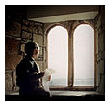The Gospel Ring (2)
Posted by Anne on Oct 20, 2015 in Naming, Writing | 0 commentsJohn’s gospel is set up with at least eleven pairs of mirror-like bookends. Some of these chiastic reflections involve numbers, most involve identical names (though not always identical people) and all involve similar thematic episodes.
Of these episodes, the most dramatic pair held up for comparison and contrast is Jesus’ resurrection coupled with Jesus casting the money changers out of the Temple. The emptying of the tomb and the emptying of the Temple, as it were.
Because the incident where Jesus made a whip to cast out the merchants and moneychangers occurs right at the beginning of this gospel and at the end of the gospel of Matthew, many commentators believe there were two similar events. One occurring at the start of Jesus’ ministry and one occurring in the week before His death on the cross.
I don’t think that’s a necessary conclusion. John marks off the days very carefully from the moment John the Baptist is asked by the leaders and priests who he is. ‘The next day…’ (John 1:29), ‘The next day…’ (John 1:35), ‘The next day…’ (John 1:46), ‘Three days later…’ (John 2:1). Altogether six days between John being asked about his identity and the threshold event of Jesus’ first miracle.
Another huge parallel here—though not within this gospel. In Matthew 16:18, Jesus asks Peter what people are saying about His identity, then six days later takes him, along with James and John, up a mountain for the threshold event of the Transfiguration. In fact, the six-day interval in both cases, along with specific words spoken at each event, suggest these pairs of incidents were exactly two (perhaps three) years apart. Both John the Baptist and Jesus wrestled with questions of identity on Yom Kippur (the Day of Atonement) and both the Transfiguration and the wedding feast at Cana occurred on the feast of Sukkot. The day for gathering in the new wine. How appropriate for what happens at Cana!
But the point is—thereafter in John’s narrative, there’s a break in the timing. He mentions that the clearing of the Temple occurred in the week before Passover but doesn’t say which one. My view is that he positioned this incident—as a literary device—to mirror the empty tomb and was no longer keeping to strict chronological order. Which he pointed out by mentioning Passover—more than half a year beyond Sukkot.
So how does the emptying of the Temple reflect the empty tomb?
Well, first of all, it’s necessary to understand about the money changers in the Temple. The reason it was necessary to have ‘foreign exchange’ booths, so to speak was because the Temple shekel—the only way an observant Jew could pay religious tax—was something no one would ever want to carry on their person. The Romans had forbidden the Jews to mint their own currency for the best part of a century, so they had to buy it from elsewhere. Only the highest quality silver was deemed acceptable for use in Temple worship—and this was only available from the mint at Tyre. Unfortunately the coins carried an image on them of the Phoenician god, Melqart, and a slogan: ‘Tyre, Holy and Inviolable’. Rather than accept a lower quality of silver, the chief priests were prepared to put up with this sacrilegious icon on the Temple currency.
Now Melqart of the Phoenicians by any other name was Molech, the god of death and child sacrifice whom the Israelites had long been forbidden to worship. Ezekiel 28 warns of the spirit behind the king of Tyre—an angel who had been a guardian of God’s throne and who was thrown out of heaven for the abundance of his trade.
Here we see the same spirit of Tyre having established a beachhead within the Temple itself. It’s turned the courts of the living God into a trading post, and not only proclaimed itself supreme—‘holy and inviolable’—but worshipped Yahweh through silver images of a god of death and child sacrifice.
Jesus always said He did only what He saw His Father in heaven doing. As Yahweh had cast out of heaven the fallen angel behind the trade of Tyre, so Jesus cast out the traders who trafficked in the same spiritual dynamic. As He overturned the tables and flung away the images of the god of death, He foretold the cleansing of the tomb in which He would soon be laid.
Death was banished: from both Temples. Here is the beauty of John’s literary device: to tell us death’s foothold is destroyed in both of physical Temple at Jerusalem and the temple which is Jesus’ body.
Gorgeous stuff!

